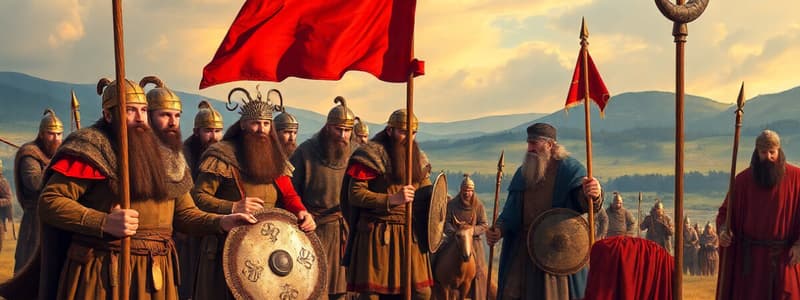Podcast
Questions and Answers
How did the Byzantine concept of Caesaropapism affect the power structure within the empire?
How did the Byzantine concept of Caesaropapism affect the power structure within the empire?
- It concentrated both civil and religious authority in the hands of the Emperor, making him the ultimate ruler in all matters. (correct)
- It granted the Patriarch significant autonomy, allowing the church to operate independently of the Emperor's direct control.
- It divided the empire into secular and religious territories, each governed by separate entities.
- It established a clear separation of powers between the Emperor and the Patriarch, preventing either from becoming too dominant.
What marked the end of the Byzantine Empire?
What marked the end of the Byzantine Empire?
- The Fall of Constantinople in 1453. (correct)
- The Seljuk Attacks of 1071.
- The Arab attacks of the 7th century.
- The Revolt of Nika.
How did the economic conditions of the Byzantine Empire differ from those of the Frankish Empire?
How did the economic conditions of the Byzantine Empire differ from those of the Frankish Empire?
- The Byzantine Empire maintained a robust and strong economy centered around Constantinople, while the Frankish Empire's economy remained weak. (correct)
- The Franks had a stronger centralized banking system, while the Byzantine economy relied on trade.
- Both empires had equally strong economies due to their strategic locations and trade routes.
- The Frankish Empire benefited from more fertile agricultural lands, leading to a more stable economy than that of the Byzantines.
How did Justinian's legal and territorial efforts contribute to the character of the Byzantine Empire?
How did Justinian's legal and territorial efforts contribute to the character of the Byzantine Empire?
Which statement accurately compares the relationship between the Emperor and religious institutions in the Byzantine and Frankish Empires?
Which statement accurately compares the relationship between the Emperor and religious institutions in the Byzantine and Frankish Empires?
If the Magyars had not been stopped at the Battle of Lech in 955, which of the following scenarios is most plausible?
If the Magyars had not been stopped at the Battle of Lech in 955, which of the following scenarios is most plausible?
Given the Vikings' reliance on wood for shipbuilding and their practice of naval invasions, which environmental consequence would most likely arise from their activities?
Given the Vikings' reliance on wood for shipbuilding and their practice of naval invasions, which environmental consequence would most likely arise from their activities?
Considering the different Viking groups and their regions of influence, which statement best reflects their impact on those regions?
Considering the different Viking groups and their regions of influence, which statement best reflects their impact on those regions?
If a Viking saga tells of a hero who calls upon Thor to create a storm to defeat his enemies in battle. Which aspect of Viking society and beliefs does this best exemplify?
If a Viking saga tells of a hero who calls upon Thor to create a storm to defeat his enemies in battle. Which aspect of Viking society and beliefs does this best exemplify?
Given the Viking expansion patterns, if a new set of runes were discovered with linguistic links to both Old Norse and a Slavic language, where would they most likely be found?
Given the Viking expansion patterns, if a new set of runes were discovered with linguistic links to both Old Norse and a Slavic language, where would they most likely be found?
Flashcards
Magyars
Magyars
A group that entered Central Europe at the end of the 9th century and was stopped in 955 at the Battle of Lech.
Vikings
Vikings
Seafaring Norsemen from Scandinavia known for raids into Europe and animal husbandry practices.
Danish Vikings
Danish Vikings
Also known as Normans, they settled in places like England, Scotland, and Sicily.
Runes
Runes
Signup and view all the flashcards
Odin
Odin
Signup and view all the flashcards
Byzantine Empire
Byzantine Empire
Signup and view all the flashcards
Justinian
Justinian
Signup and view all the flashcards
Corpus Juris Civilis
Corpus Juris Civilis
Signup and view all the flashcards
Caesaropapism
Caesaropapism
Signup and view all the flashcards
Iconoclasm
Iconoclasm
Signup and view all the flashcards
Study Notes
Central Europe
- Magyars arrived at the end of the 9th century and settled in the Pannonian Basin.
- In 955 they were defeated by the Germans along the Lech River.
- Vikings originated from Scandinavia.
- Developed a complex social structure.
- Used ships to travel across Europe.
- Three groups of Vikings:
- Anglo-Saxon Vikings- England, Scotland, Normandy, and Sicily.
- Norse Vikings- Iceland, Vinland(Greenland), and Scotland.
- Swedish Vikings- Varied trade routes extending eastwards to the area that is now Russia.
- The Vikings traded and raided locations as far apart as the Middle East and North America.
Runes/ Sagas/ Poetry
- Runes were early Germanic alphabet used for inscriptions and writing.
- Sagas were stories passed down through generations.
- Poetry was used for storytelling and to preserve cultural history.
- Notable figures involved in Viking sagas and poetry
- Odin- ruling Norse God
- Thor- known for his mighty strength
- Tyr- known for his courage
Studying That Suits You
Use AI to generate personalized quizzes and flashcards to suit your learning preferences.
Description
Vikings originated from Scandinavia and were divided into three groups, traded and raided locations. Magyars arrived at the end of the 9th century and settled in the Pannonian Basin. Runes were early Germanic alphabet used for inscriptions and writing. Sagas were stories passed down through generations.




